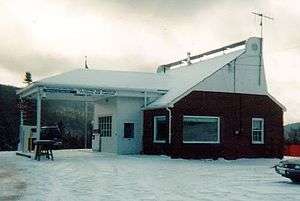Pittsburg-Chartierville Border Crossing
| Pittsburg-Chartierville Border Crossing | |
|---|---|
|
Pittsburg, NH border station, as seen in October, 1997 | |
| Location | |
| Country | United States; Canada |
| Location |
US Port: US Route 3, Pittsburg, New Hampshire 03592 Canadian Port: Highway 257, Chartierville, Quebec J0B 1K0 |
| Coordinates | 45°15′10″N 71°12′18″W / 45.252715°N 71.204957°W |
| Details | |
| Opened | 1949 |
| US Phone | (819) 656-2261 |
| Canadian Phone | (819) 844-2262 |
| Hours |
US side: Open 24 Hours Canadian Side: Open 8:00am - midnight |
|
Website http://www.cbp.gov/xp/cgov/toolbox/contacts/ports/vt/0206.xml | |
The Pittsburg-Chartierville Border Crossing connects the towns of Chartierville, Quebec and Pittsburg, New Hampshire. It is the only international land border crossing in the state of New Hampshire. Pittsburg is notable for being the largest township (in terms of land area) in the continental United States.[1] Although the US operated a border station at Connecticut Lakes as far back as the 1930s, the facility consisted of a small one-room structure, and later a mobile home. The US did not have a permanent inspection facility at the border until 1960, and the northernmost stretch of US Route 3 remained unpaved until about 1970. In 2012, the United States built a new border inspection facility.
Incident Related to the Millennium Terror Plot

In 1997, the Pittsburg border station was equipped with a Remote Video Inspection System (RVIS), which enabled people to enter the US at this crossing 24 hours per day, even though at that time the station closed at 5:00PM. On the evening of December 15, 1999, a Canadian woman named Lucia Garofalo tried to use the RVIS to smuggle an Algerian man and a trunk full of what was later suspected to be explosives into the US. The remote inspector refused to allow her to enter, and she was then put onto a watchlist. On December 19, she was apprehended when she tried to enter the US at the Beecher Falls-East Hereford Border Crossing with another Algerian man. Garofalo was found to have ties to Ahmed Ressam, an Algerian member of al-Qaeda who was arrested by US Customs Service officials in Washington state on December 14, 1999, when he tried to enter the US with a car full of explosives, with the intent to detonate them at the Los Angeles International Airport. At Beecher Falls, the vehicle had no explosives, but trace elements were detected, indicating it had previously contained explosive material. It was never revealed what was exactly being plotted, but the arrest of these individuals apparently made it impossible for al-Qaeda to carry out its planned attack.[2]
Garofalo was prosecuted on alien smuggling charges, largely on the strength of the audio recording of her declarations via the RVIS. Statements she made that evening, which included that her traveling companion was her brother, were later proven to be untrue. At that time, the Pittsburg border station was the only one of the 163 US land border stations where both audio and video of primary inspections were recorded.
In spite of this successful outcome, this incident prompted the Immigration and Naturalization Service to cease using the RVIS system. The program as a whole was decommissioned following the September 11 attacks.
See also
References
- ↑ http://www.pittsburg-nh.com
- ↑ Martin, Gus (2004). The New Era of Terrorism: Selected Readings. Thousand Oaks, CA: Sage Publications. p. 95. ISBN 0-7619-8873-4.
